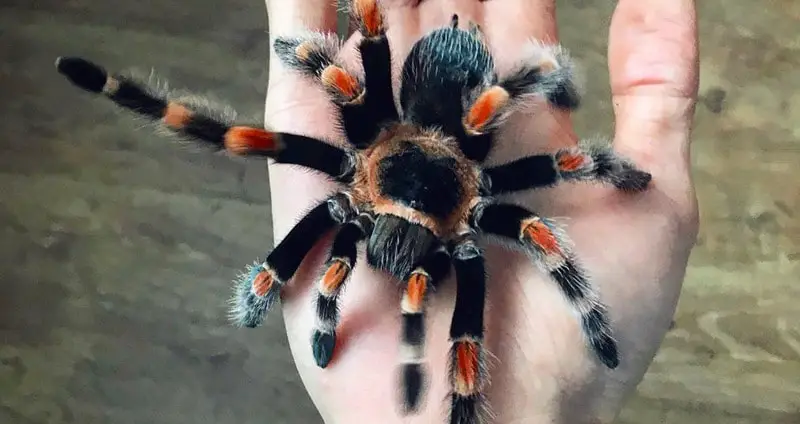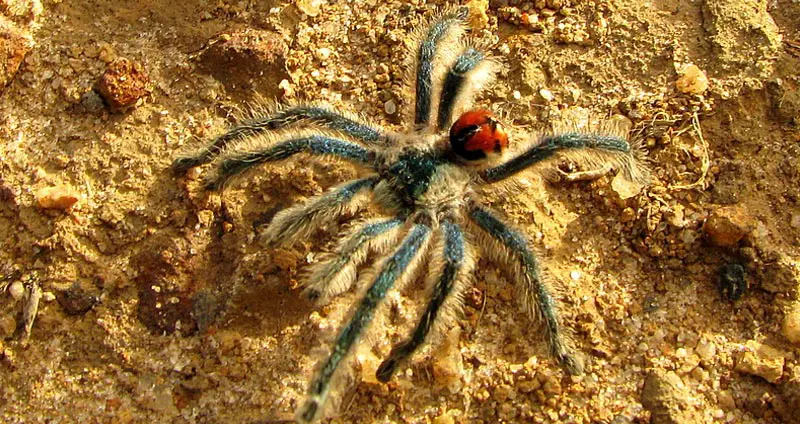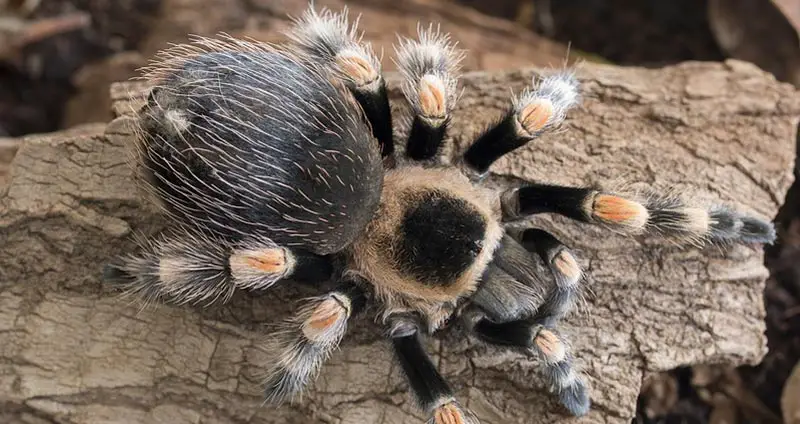The Mexican Redknee tarantula, also known as Brachypelma hamorii and formerly known as Brachypelma smithi, gets its name from the red-orange spots on its legs.
Of the more than 800 tarantulas discovered so far, the Mexican Redknee tarantula has one of the most iconic appearances, a gentle nature, and an incredibly long life span — up to 40 years!
Table of Contents
Brachypelma hamorii Care Sheet
| | |
Common Name |
Mexican Redknee |
Species Type |
New world terrestrial |
Natural Habitat |
Found in warm, dry regions of Mexico. |
Growth Rate |
Slow growth rate. It takes several years for them to reach full size. |
Adult Size |
Females reach a legspan of about 6.5″, with males measuring slightly smaller. |
Lifespan |
Females can live up to 30-40 years, while males only live up to 5 years. |
Enclosure |
The enclosure should be wider than it is tall, with an emphasis on floor space. 6″ of substrate should line the bottom of the enclosure, and a sizeable hide and water dish should also be present. |
Temp/Humidity |
76°F to 80°F with about 65% to 75% humidity. |
Diet |
Not a very ravenous eater, but adults can eat several adult-sized crickets per week. |
Temperament |
Extremely docile and friendly. Almost never throw up threat poses or flick hairs. One of the most frequently-handled species. |
Experience Level |
Beginner – Very easy to care for and extremely friendly. Perfect for novice keepers. |
Average Cost |
Slings ~ $35, Males ~ $80, Females ~ $120+ |
Brachypelma hamorii Appearance
The Mexican Redknee tarantula is every spider lover’s preferred pet of choice because of its unique coloration and a docile personality.
They have beautiful red and orange speckles on their knees which strongly contrast against their relatively dark body. The carapace on these creatures is creamy beige along with a distinct black square.
These spiders grow to a sizable 7” to 8” in leg span if they’re given proper nutrition, with females growing to a larger size than males.
Like other members of the Brachypelma subfamily, the Mexican Redknee has a slow growth rate, reaching their full growth potential at 7 years of age. In general, females will have done growing at the age of 7 while males will stop growing after reaching 5 years of age.
The spiderlings will are pale compared to fully grown adults with a pale torso and bright orange body. They are very active in their cages, making them fun to observe. It is worth noting that the growth rates for these tarantulas are quite slow, so it will take a few years before one of your spiderlings reaches full maturity.

via @exotic_venomo / Instagram
Brachypelma hamorii Temperament
B. hamorii is a new world tarantula, meaning that they tend to be more calm, friendly, and have a preference to run from danger as opposed to fighting it. It’s because of this friendlier disposition that Brachypelma has become a very popular genus.
As a new world tarantula, this species possesses urticating hairs that they can flick at predators and cause severe irritation. While they do this very infrequently, it can happen, so handling must be done with care (or avoided altogether to be safe).
However, this doesn’t stop many enthusiasts from carrying their Brachypelma hamorii around wherever they go. If you go to a pet show and someone has their tarantula out, it will likely be a friendly B. hamorii.
In their enclosure, this tarantula makes for a great display species. They spend most of their time out and about just relaxing. They aren’t very energetic, but you’ll almost always be able to keep an appreciative eye on them
Housing Brachypelma hamorii
The best part about caring for tarantulas in the Brachypelma family is that they don’t require complicated enclosures. All that you need for this tarantula is a suitably-sized hide and a water bowl, along with a good climate.
If you don’t want to invest in an expensive cage, you can make do with makeshift containers as well.
Optimal Brachypelma hamorii Enclosure
This is a bit of a larger tarantula that reaches a legspan of 7″, so a larger terrestrial enclosure is required. Specifically, this 18″ x 18″ x 12″ Exo Terra terrarium is perfect for Brachypelma hamorii.
This particular enclosure has great cross-ventilation, build-quality, visibility, and accessibility — all traits that are very important in tarantula enclosures.
Spiderlings can be kept in smaller containers as long as they’re also given the proper supplies and there’s good ventilation. Adults shouldn’t be kept in enclosures much smaller than what’s been highlighted above.
Enclosure Decorations
The Mexican Redknee tarantula is a fairly low maintenance exotic pet and doesn’t need too many supplies. They’re burrowing terrestrial tarantulas in nature, so make sure the substrate is of a decent depth — ideally 6″.
While Brachypelma hamorii prefers sandy substrate in nature, you’ll be fine with supplying them with 6″ of moisture-retaining coconut fiber substrate. Your enclosure should also contain a tarantula hide on the ground level (slightly buried).
You can use coconut halves, plant pots, and cork bark as affordable solutions. Make sure your spider can fully conceal itself in the hide.
Don’t forget to place a water dish in the terrarium, slightly tucked under the ground such that the rim line lies above the substrate. It’s important to regularly clean and refill this water bowl as Brachypelma hamorii will drink from it.
Although decorations for the cage are not too important, you could make the environment more natural-looking by adding fake plants. Don’t go for live plants since they require too much maintenance and more light than a tarantula would be comfortable with.
Enclosure Humidity/Heating
The native habitat of B. hamorii is arid and dry. Humid environments can be harmful, so avoid soggy enclosures.
The ideal enclosure should be well ventilated to prevent the accumulation of moisture. That being said, you should spray the cage once a week to raise the humidity levels for a short time, before letting it drop again. Water dishes can also be overfilled to dampen the substrate around it.
Make sure the substrate isn’t saturated with water — it should merely be damp. B. hamorii thrives at around 65% to 75% humidity levels.
In terms of temperature, the Mexican Redknee prefers somewhere around 75°F to 80°F at all times. While this is room temperature for most people, if your home drops below this temperature, you may have to provide supplemental heating through a space heater.
It is highly recommended to monitor the Mexican Redknee’s humidity and temperature levels with the help of a hygrometer and a thermometer respectively.
Diet
Mexican Redknee tarantulas have a slow-to-medium growth rate and aren’t ferocious eaters. However, to allow for healthy growth and to support their long lifespan, a good diet is necessary!
The slings will eat smaller insects such as pinhead crickets or flightless fruit flies (the insect should be 3/4th their size max). Adults can eat normal-sized crickets several times per week.
Once your tarantula has eaten its food, clear away any leftovers from the enclosure. If your Mexican Redknee is gesticulating on its back, it might be getting ready to molt.
Do not disturb the tarantula during this sensitive period. It will be soft and vulnerable 1 to 2 weeks after it’s done molting, so do not feed it anything during this time.
Health Concerns
B. hamorii doesn’t require much in the way of special maintenance and care. They are fairly independent species and prefer to be left alone to their own devices. Just make sure that the enclosure is within the ideal humidity and temperature levels and you’re good to go.
Parasite/mite infestations and dehydration are problems that may occur with captive-held pet tarantulas, but they’re easy to avoid and deal with. A mite infestation can be prevented by regularly cleaning the vivarium.
Like all other tarantulas, the Mexican Redknee is susceptible to fall damage and should never have the opportunity to fall from a far distance.
Brachypelma hamorii For Sale & Price
Due to the overwhelming popularity of these tarantulas, they are frequently sold for very affordable prices. Compared to other species, they’re one of the most accessible tarantulas out there.
You can find this species being sold on various online marketplaces for as little as $35 for a sling and as much as $120 for a mature female.
Considering the fact that females can live for 40 years, this is an insanely cheap price for this tarantula. It’s long-living, friendly, attractive, and great fun to watch — you won’t find a better way to spend your money!

